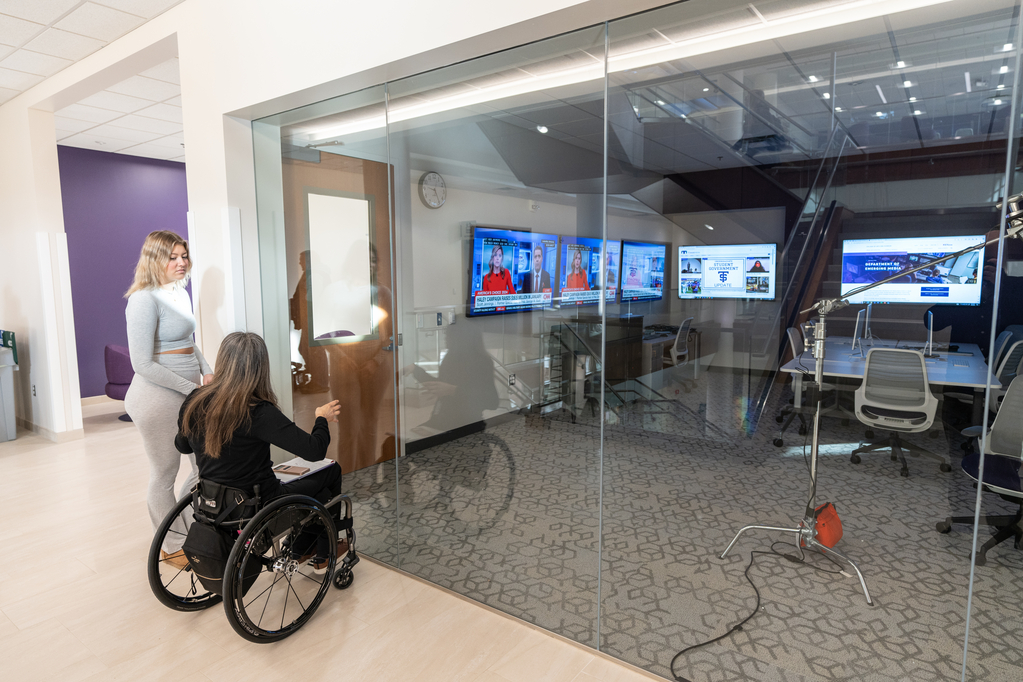UST entrepreneurship students in Silicon Valley today toured Plantronics’ state of the art headquarters in Santa Cruz to learn about the company’s new innovations. They then met with the CEO, CTO and the VP of New Ventures and Innovations for a conversation about company culture, intrapreneurship and identifying and pursuing opportunities. They continued interviewing local residents for feedback on their business plan projects.
Day two of our adventure in Silicon Valley began with great anticipation. We hit the road for a two-hour journey to Plantronics, a Santa Cruz-based headset company known for superior sound, style and comfort. With every mile of the curvy road traveled, we soaked in glimpses of ocean along steep cliffs as our collective intrigue and excitement built steadily.
Our tour of the company began with an audio clip spoken by astronaut Neil Armstrong, crisply transmitted, of course, through a Plantronics headset. The informative tour was highlighted by the innovation and technology of Plantronics, as well as the creativity inducing working environment of the campus itself.
It was clear that great thought and planning went into the design of the unique campus, which exudes creativity and imagination, a sophisticated structure and wide variety of building materials. Every square inch was littered with creativity, colors and textures across walls and furnishings, creating a complex, yet beautiful space complete with soothing waterfalls, exotic fish tanks, a comprehensive workout center and a plethora of modern and ergonomic furniture. The unique environment and comfortable workplace even seemed to blend seamlessly into the employees’ passion and happiness.
Upon completion of the awe-inspiring tour, we were able to sit down with Evan Benway, a Plantronics product manager in his third year with the company. We learned quickly that the work environment correlates directly with what they call, “Smarter Working,” a work-when-you-want policy that allows employees to work when they feel they are most productive. He said employees feel less pressure and, by extension, end up loving what they do even more. This workplace approach also establishes trust and loyalty among employees and certainly helps to attract and retain top talent. Plantronics is to be credited for the flexible work environment, which is at the cusp of a large, innovative trend seeping into modern corporate ideology.
We all agreed that this flexible environment in action was compelling and inspiring. This was further enhanced upon exiting the building when we were engaged by a very curious gentleman, later revealed to us as a vice president at the company. In fact, it emphasized a core trait of flexible work environments like this; namely, that titles are a mere formality as everyone works together with a single vision as one connected team. We were very impressed with how this now 50-year-old company has been able to evolve and continually reinvent itself throughout the years.
As part of his discussion with us, Evan shared how he submitted a resume for an internship, but also took the initiative to contact the president of human resources with the objective to stand out among thousands of other applicants. Essentially, he created opportunities for himself as opposed to simply waiting for something to happen – a characteristic that has become vital in today’s competitive workplace. As a group, we determined that work ethic stems from humility. As such, we need to harness our internal drive to strive for our goals and be relentless in our pursuit to reach them.
As the day drew on, we continued to explore our empathy research in Santa Cruz. My group, which includes Mike and Luke, found difficulty reaching a enough people to interview in the heart of a resort area, while other groups flourished at the University of California, Santa Cruz. We’ll continue to gain insights about for our project about the rental market in a more residential area with less emphasis on tourism in following days. The interviews completed perfectly set the stage for diving into the unpacking process of design thinking within which we organize our research and determine a focus. This will lead us into the second half of our first cycle within the design thinking process.







